 I made three batches of corn soup last week in less than three days time. Sweet Walter purchased me the Vitamix blender I've been eying for years as an early birthday present, and I was eager to test out its power. But in my attempt to develop a restaurant-worthy summer soup, I hit a few (culinary) speed bumps along the way.
I made three batches of corn soup last week in less than three days time. Sweet Walter purchased me the Vitamix blender I've been eying for years as an early birthday present, and I was eager to test out its power. But in my attempt to develop a restaurant-worthy summer soup, I hit a few (culinary) speed bumps along the way.
I initially set out to create a recipe that was the essence of sweet corn, with no underlying flavors getting in the way. Because I didn't add potatoes or start with a roux—in addition to the power of the Vitamix—my soup came out much too thin for my liking. Which brings us to thickening agents. Y'all know I like to get all "scientist-y" every now and then, so I decided to think outside the yellow cornstarch box.
I thickened my first batch of soup with potato starch after reading this article from The Kitchn. (My girl Sarah Rae knows her stuff, so I took the info to heart.) Potato starch is made in two steps: first, the potatoes are peeled and ground. Next, they are washed to remove the starch, which in turn is dried to yield 100 percent potato starch. It should be added at the end of cooking (as opposed to at the beginning, like flour) and doesn't alter the taste of a dish like other thickeners can.
Upon first eating my now-delicious-and-rich corn soup, I was really happy with the results. So much so, I thought I struck recipe gold on the very first try. But after leaving the soup at room temperature for about an hour, I re-tasted it only to find blobs of gel at the bottom of the soup. I had read somewhere that potato starch was more apt to resist congealing upon cooling than other starches, so I wondered if I had done something wrong?
I preformed test two and three at the same time, using the same base recipe as test one. For test two, I added one peeled, diced russet potato to the corn & vegetables at the same time I added the stock. The potato was pureed with the rest of the soup to yield a more substantial texture requiring no additional thickeners. I really, really liked the soup, but there was definitely a hint of potato flavor, making my soup more "chowdery" than I would have liked; I wanted silky, glossy, and smooth.
Enter tapioca starch (also known as tapioca flour), a thickener made famous in its use in puddings and pies. Tapioca starch has been gaining popularity in restaurant kitchens for its many positive qualities—it thickens at a low temperature, remains stable when frozen, and imparts a glossy sheen to its finished products. And while "instant tapioca" can have trouble dissolving, leaving behind small gelatinous blobs, tapioca starch is so finely ground it does not have this same problem.
I added the tapioca starch (two tablespoons cornstarch to three tablespoons water) into my soup just a few minutes before serving and was amazed at the instantaneous results. The texture was like velvet and the taste was of pure corn. Even better, the soup kept its shape after a few days in the fridge. (What, did you think I could actually eat three batches of soup in a day?) All my requirements having been met, I think I found a winner.
Of course, I don’t consider myself an expert on the subject of thickening starches; in fact, I know I have a lot more experimenting to do before I will have a complete grasp on them all. But I look forward to learning more, especially with this yellow cake that uses potato starch on my radar. I also want to play around with xanthan gum and clearjel, so look out for more lab results soon!
In the mood to dork out on starches? Here are some additional sources:
All About Thickeners (Baking 911)
What's the Difference? Flour, Cornstarch, Potato Starch, and Arrowroot (The Kitchn)
How Do Chef's Stabilize Sauces? (Google Answers)
Two Thickeners: Tapioca and Cornstarch (Cook's Illustrated)
P.S. Check out the Sweet Corn Soup over at The Kitchn
Image Source: King Author Flour
 Simple is best. When it comes to cooking that is usually the case, however behind every great chef lies a few well-kept secrets. Thankfully, I love nothing more than uncovering their hidden gems. I am constantly tampering with obscure ingredients from sometimes-shady internet sources. (Like, there may or may not be contraband vanilla extract in my pantry that arrived in an unmarked envelope from the depths of Mexico...)
Simple is best. When it comes to cooking that is usually the case, however behind every great chef lies a few well-kept secrets. Thankfully, I love nothing more than uncovering their hidden gems. I am constantly tampering with obscure ingredients from sometimes-shady internet sources. (Like, there may or may not be contraband vanilla extract in my pantry that arrived in an unmarked envelope from the depths of Mexico...)
